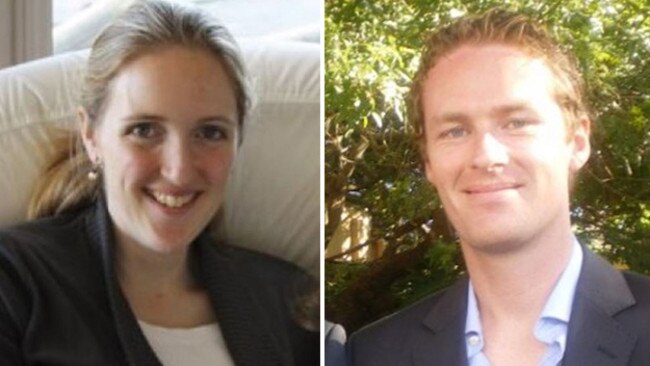Sydney siege inquest: Lindt cafe manager Tori Johnson’s final text message
The Lindt Cafe manager’s ominous text message revealed, as police commander denies bungling a previous terror incident.
Thirty minutes before he was shot dead by gunman Man Haron Monis, Lindt Cafe manager Tori Johnson sent an ominous text to his loved ones.
“He’s increasing agitated ... walks around when he hears a noise outside with a hostage in front of him ... wants to release one person out of good faith — tell police,” the text, sent at 1.43am on December 16, 2014, read.
The message was conveyed to police 10 minutes later, but Assistant Commissioner Mark Jenkins, who was in command of the siege at the time, says he was never made aware of it.
Mr Jenkins said he would not have expected to receive news of the text from his position at Police Operations Command, but agreed it was important information for those at the front line.
“It’s certainly important from a forward command position, yes,” Mr Jenkins told an inquest this morning.
Hours earlier, at 10pm, Mr Johnson had sent another text to his loved ones: “I love you all — still alive — very scared.”
Mr Jenkins told the inquest he was not made aware of this text, either.
Police stormed the cafe at 2.13am after Monis shot Mr Johnson dead from point-blank range.
Barrister Katrina Dawson died after being hit by a police bullet as they stormed inside, while Monis was also killed.
Mr Jenkins has been forced to defend his record amid accusations he bungled a previous terrorist incident.

Gabrielle Bashir, counsel for Mr Johnson, grilled Mr Jenkins about a 2005 incident in which he ordered four police officers to arrest Omar Baladjam during Operation Pendennis, when 16 terrorists were arrested in Sydney and Melbourne.
Mr Jenkins reportedly directed the four community police from Green Valley police station to arrest Baladja, even though 400 special operations officers were in the area that day, according to police files.
An internal review found Mr Jenkins failed to tell them Baladjam was violent and often armed and was a member of a known terrorist cell.
In the shootout in 2005, which was described as a “screw-up” by then Opposition Leader Peter Debnam — none of the four arresting officers were wearing bulletproof vests as Baladjam opened fire.
A NSW police officer was shot in the hand and Baladjam suffered a bullet wound to the neck.
A damning report said he “failed in the duty of care’’ by not “adequately warning’’ and had put the officers’ lives at risk.
The report on Mr Jenkins was given to the Professional Standard Unit run by then-Superintendent Cath Burn, who directed Mr Jenkins be counselled about his failure to warn officers of the dangers.
This afternoon, Ms Bashir asked Mr Jenkins: “It’s the case isn’t it that you have misjudged the level of risk of a terrorist before?”
“No that’s not the case,” Mr Jenkins replied.
“You have had managerial counselling as a result of … an earlier critical incident involving a terrorist wearing a backpack who shot police officers?” she said.
“You didn’t mention that to the coroner in your half hour going through your medals and experience did you?”
“No I didn’t,” he said.
“It’s the case that you failed to appreciate risk and dangerousness previously?”
“No that’s not the case,” he replied.
“And you failed to do that in the early hours of 16 December?”
“No I don’t agree with that at all,” he replied.
Commanding officer defends operation actions
Mr Jenkins was repeatedly pressed to reveal if he would have supported police storming the cafe when Monis first discharged his gun at 2.03am, if they’d known he was aiming at a group of fleeing hostages, and not above their heads as police first believed. “If I was convinced the shot was made directly at hostages then yes, I would have thought an EA (emergency action) should have been activated ... but I was not told that at the time and I don’t know that to be the case today,” he told the inquest.
Mr Jenkins was again pushed to state what his attitude would have been if he’d known Monis shot at the hostages.
“If there was unequivocal evidence that the shot was at hostages then that would have raised the level to an imminent threat of serious injury or death, and that would have warranted an EA,” he said.
But later, Mr Jenkins insisted storming the cafe was never his decision to make.
“It’s the forward commander’s responsibly to call an EA,” he said.
Mr Jenkins was also grilled about whether it was a “lost opportunity” for police to have failed to arrange for the lights in Martin Place to be switched off, as repeatedly requested by Monis from 8.38pm.
Hostage Selina Win Pe made four calls between 12.48am and 1.12am begging for the lights to be turned off and warning Monis had threatened to shoot her unless this was done.
The inquest heard that switching off the lights might have been an opportunity for police negotiators to engage with Monis, and also a tactical advantage for police, because when they entered the café at 2.13am they were lit by the lights outside, while Monis was inside a darkened café.
Asked if this was a “lost opportunity”, Mr Jenkins replied: “Certainly I would have liked to have had the lights turned off as quickly as possible”.
However, Mr Jenkins said he was not aware at the time whether the lights could be turned off or not, and did not realise that officers had already done the “leg work” to ensure the lights could be turned off quickly if the decision was made to do so.
Mr Jenkins agreed it was “very disappointing” that he was not aware of this information.
Also at the inquest today, Mr Jenkins appeared to contradict his earlier evidence that NSW Police Commissioner Andrew Scipione had insisted during a telephone conversation at 10.57pm that “direct action” involving police forcing entry to the café at a time of their choosing, was to be a “last resort”.
Today, Mr Jenkins said he believed these were his own words to Mr Scipione, rather than the other way around.
With AAP


